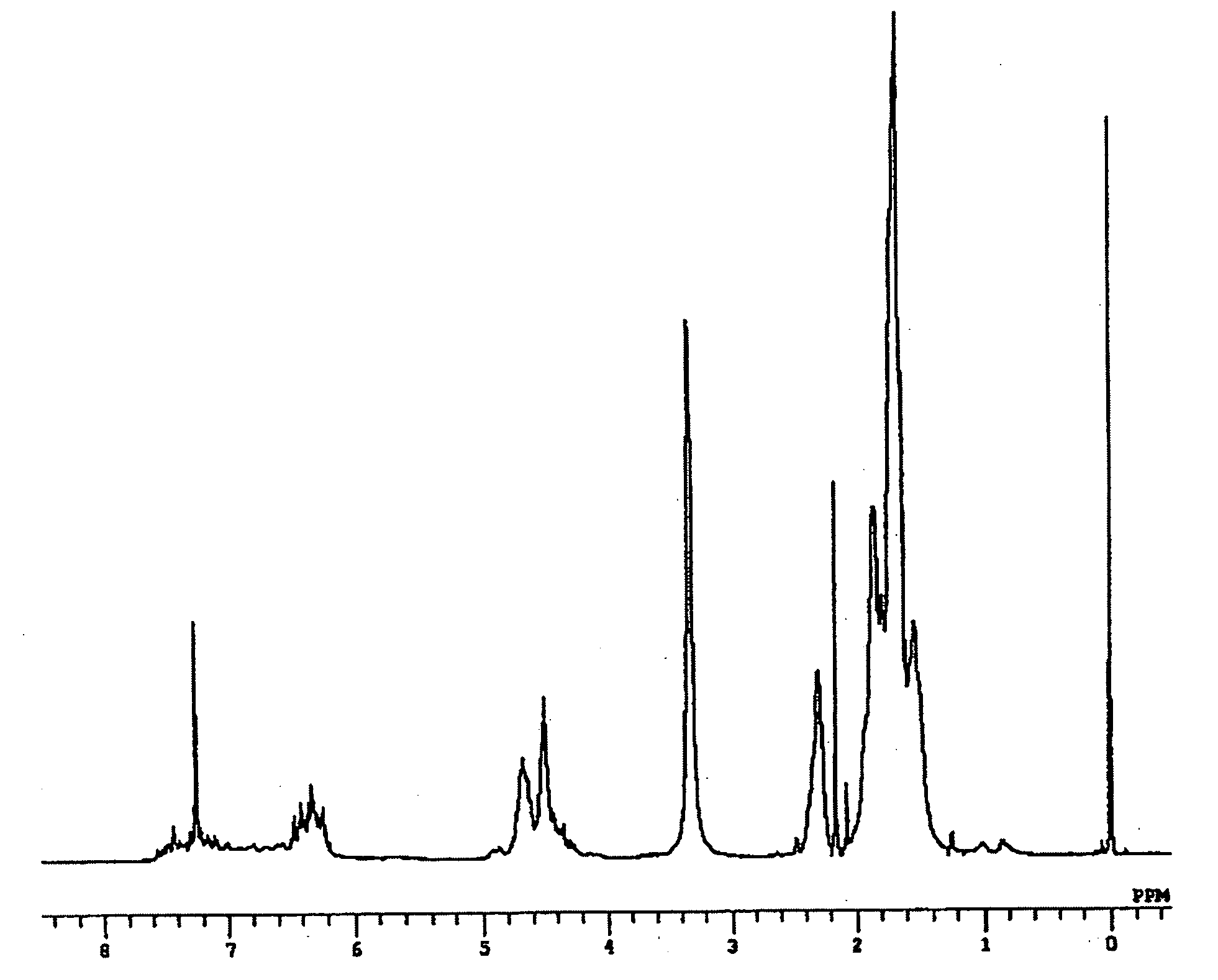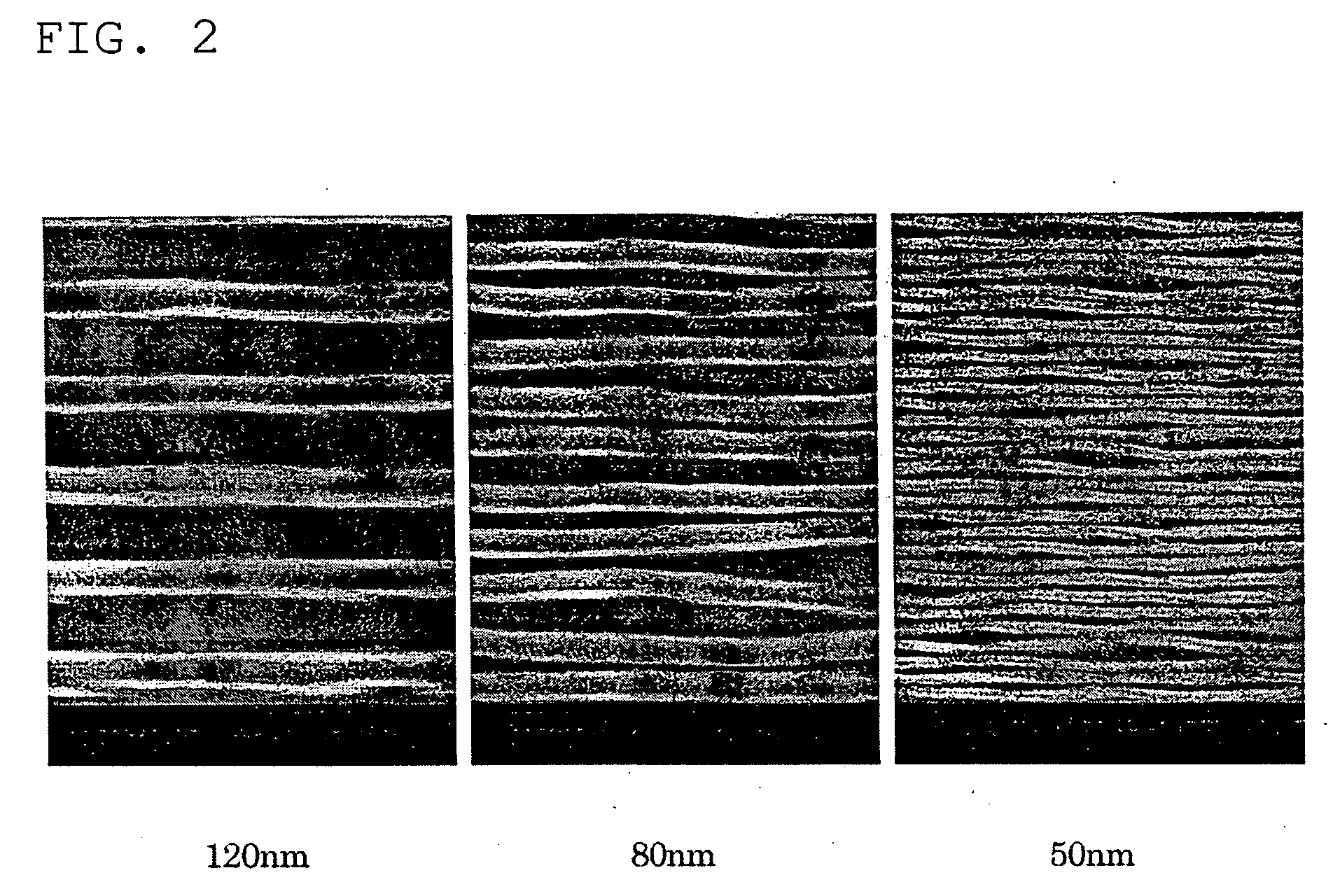Calixresorcinarene compounds, photoresist base materials, and compositions thereof
a technology of photoresist and compound, applied in the field of calixresorcinarene compound, photoresist base material, and compositions thereof, can solve the problems of large amount of resist out-gas, large line edge roughness, and low sensitivity, and achieve excellent applicability and capability, excellent strength
- Summary
- Abstract
- Description
- Claims
- Application Information
AI Technical Summary
Benefits of technology
Problems solved by technology
Method used
Image
Examples
example 1
Photoresist Base Material
(1) Synthesis of calix-[4]-resorcinarene
[0098] A three-neck flask (volume: 500 ml) equipped with a dripping funnel, a Dimroth condenser, and a thermometer, sufficiently dried and replaced with nitrogen gas, was encapsulated with resorcinol (33 g, 300 mmol) and acetaldehyde (17 ml, 300 mmol) in a nitrogen stream. Then, distilled methanol (300 ml) was added under a slight pressure of nitrogen gas to obtain a methanol solution. The methanol solution was heated at 75° C. on a oil bath while stirring. 75 ml of a concentrated hydrochloric acid solution was slowly added by dripping from the dripping funnel, followed by continued stirring with heating at 75° C. for two hours. After completion of the reaction, the mixture was allowed to cool to room temperature, followed by cooling on an ice water bath. The reaction mixture was allowed to stand for one hour. White raw crystals of the target compound were produced and collected by filtration. The crude crystals wer...
preparation example 1
Photoresist Base Material
(1) Synthesis of calix-[4]-resorcinarene
[0100] A three-neck flask (volume: 500 ml) equipped with a dripping funnel, a Dimroth condenser, and a thermometer, sufficiently dried and replaced with nitrogen gas, was encapsulated with resorcinol (33 g, 300 mmol) and acetaldehyde (17 ml, 300 mmol) in a nitrogen stream. Then, distilled methanol (300 ml) was added under a slight pressure of nitrogen gas to obtain a methanol solution. The methanol solution was heated at 75° C. on a oil bath while stirring. 75 ml of a concentrated hydrochloric acid solution was slowly added by dripping from the dripping funnel, followed by continued stirring with heating at 75° C. for two hours. After completion of the reaction, the mixture was allowed to cool to room temperature, followed by cooling on an ice water bath. The reaction mixture was allowed to stand for one hour. White raw crystals of the target compound were produced and collected by filtration. The crude crystals wer...
example 2
Photoresist Composition
[0103] A solid mixture consisting of 87 parts by weight of calixresorcinarene compound obtained by washing with an acidic solution, treating with an ion-exchange resin, and removing basic impurities in Preparation Example 1(3), as a base material, 10 parts by weight of triphenylsulfonium trifluoromethanesulfonate, as a PAG, and 3 parts by weight of 1,4-diazabicyclo[2.2.2]octane, as a quenching agent, was dissolved in 2-methoxyethanol to a solid concentration of 20 wt %, thereby obtaining a photoresist solution (photoresist composition). The photoresist solution was applied onto a silicon wafer by spin coating (4,000 rpm, 60 sec) and baked at 90° C. for 180 seconds to form a thin film with a thickness of 200 nm. The substrates to which the coating was applied were exposed to an electron beam at a dose of 20 μC / cm2 using an electron beam exposure equipment (“JBX-5DR” manufactured by JEOL Ltd.) to draw line-and-space patterns with a line width and a line-to-line...
PUM
| Property | Measurement | Unit |
|---|---|---|
| roughness | aaaaa | aaaaa |
| roughness | aaaaa | aaaaa |
| diameter | aaaaa | aaaaa |
Abstract
Description
Claims
Application Information
 Login to View More
Login to View More - R&D
- Intellectual Property
- Life Sciences
- Materials
- Tech Scout
- Unparalleled Data Quality
- Higher Quality Content
- 60% Fewer Hallucinations
Browse by: Latest US Patents, China's latest patents, Technical Efficacy Thesaurus, Application Domain, Technology Topic, Popular Technical Reports.
© 2025 PatSnap. All rights reserved.Legal|Privacy policy|Modern Slavery Act Transparency Statement|Sitemap|About US| Contact US: help@patsnap.com



